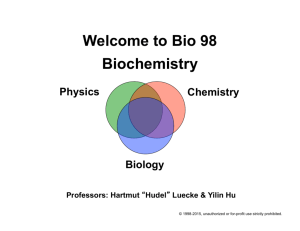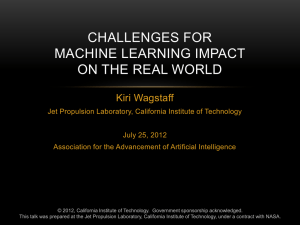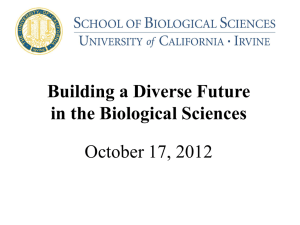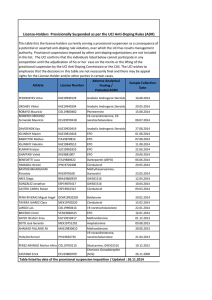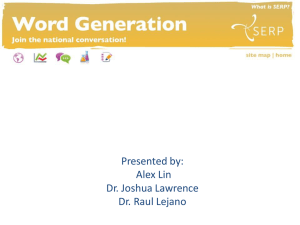bio98a_l01
advertisement
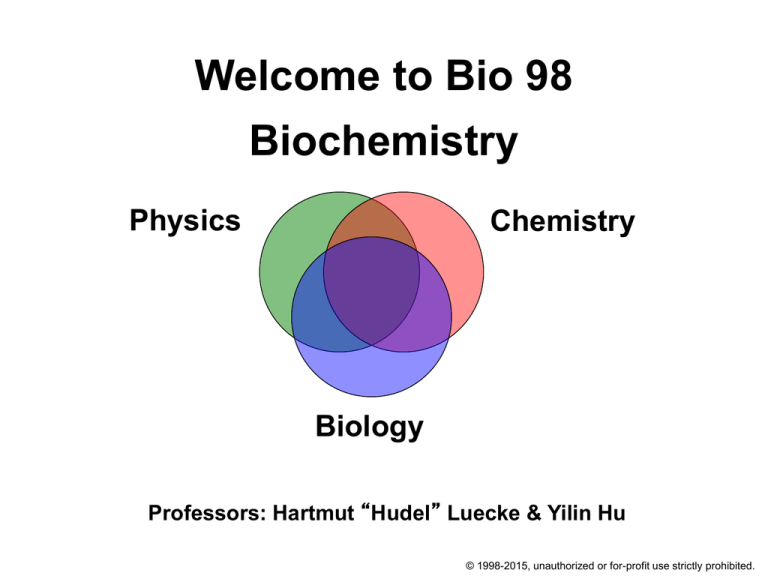
Welcome to Bio 98 Biochemistry Physics Chemistry Biology Professors: Hartmut “Hudel” Luecke & Yilin Hu © 1998-2015, unauthorized or for-profit use strictly prohibited. Hartmut “Hudel” Luecke Department of Molecular Biology & Biochemistry Area of research: Structure & function of proteins Office Hours: Make appointment via email Email: hudel@uci.edu (Please put “bio98” in subject line of all emails) • Class web sites: https://eee.uci.edu/15w/05350 http://urei.bio.uci.edu/~hudel/bs98a/index.html • How to do well in this course: Assigned reading – before each lecture Lectures – attend!!! Problems – try / read / try again Discussion sections – go prepared! Discussion sections & tutoring Bio 98 TAs (Luecke part) • • • Section 1 (Alborz Karimzadeh, akarimaza@uci.edu): week of Jan 12 Section 2 (Rutav Mehta, tutavm@uci.edu): week of Jan 26 Section 3 (Luke Nelson, lukejn@uci.edu): week of Feb 2 UCI Bio Sci Peer Tutoring • • Allen Khai (khaia@uci.edu) Nobel Nguyen (nobeln@uci.edu) LARC Tutoring • Allen Tran (avtran1@uci.edu) • John Ngo (jtngo2@uci.edu) Biochemistry Physics Chemistry Biology Biochemistry Biochemistry ATP http://en.wikipedia.org/wiki/Adenosine_triphosphate Metabolic processes that use ATP as an energy source convert it back into its precursors. ATP is therefore continuously recycled in organisms: the human body, which on average contains only 250 grams (8.8 oz) of ATP, turns over its own body weight in ATP each day. ATP Central Dogma of Biology replication DNA (4 bases: dA, dT, dG, dC) transcription RNA (4 bases: A, U, G, C) translation PROTEIN (20 amino acids) PROTEINS • enzymes – catalyze chemical reactions • transport – move molecules • receptors – transduce signals • structural proteins – architecture of cells Bio 98: Structure & function of proteins; metabolic reactions, lipids and carbohydrates. Bio 99: Informational macromolecules: DNA and RNA, replication, transcription & translation. Outline of Today’s Lecture I. Structure and properties of water A. Life depends on water B. Unusual and important properties of water II. Biochemical forces A. Strong vs. weak forces (bonds) B. Non-covalent forces: general features C. Four types of non-covalent interactions I. STRUCTURE AND PROPERTIES OF WATER No water = No life Most living organisms contain about 70% water I. STRUCTURE AND PROPERTIES OF WATER Oceans hold 97% of surface water, glaciers and polar icecaps 2%, ground water and land surface water such as lakes & rivers 1%. I. STRUCTURE AND PROPERTIES OF WATER B. Unusual and important properties of water: 1. Water is the only substance that exists in all three physical states of matter on earth. 2. High boiling & melting points for such a small molecule; compare water with ethanol (mass of 18 vs. 46 Dalton). 3. Density of liquid water > density of ice. 4. Very polar - metabolites and ions are soluble - but lipids are not. I. STRUCTURE AND PROPERTIES OF WATER B. Unusual and important properties of water: 1. Water is the only substance that naturally exists in all three physical states of matter on earth: solid, liquid and gas I. STRUCTURE AND PROPERTIES OF WATER B. Unusual and important properties of water: 2. High boiling & melting points for such a small molecule; compare water with ethanol (mass of 18 vs. 46 Dalton). I. STRUCTURE AND PROPERTIES OF WATER B. Unusual and important properties of water: 3. Density of liquid water > density of ice. When water freezes it expands rapidly, increasing about 9% in volume. Pure water has a maximum density at 4 °Celsius. Water is the only substance where the maximum density does not occur when solidified. As ice is less dense than liquid water, ice floats on water. I. STRUCTURE AND PROPERTIES OF WATER B. Unusual and important properties of water: 3. Density of liquid water > density of ice. What would happen if ice did not float on water? I. STRUCTURE AND PROPERTIES OF WATER Density of liquid water I. STRUCTURE AND PROPERTIES OF WATER 1. Oxygen has 6 valence electrons 2. Uses bonds to H atoms to fill valence shell (8) 3. Large dipole moment 4. Can form extensive H-bonding network (donate 2 and accept 2 H-bonds per water) Dipoles + d H d- O H d+ Arrow indicates direction of dipole. The greater the charge separation, and the greater the (partial) charges, the greater the dipole moment. Polar molecules and dipoles d+ C O d- C dN d H + H H + d d+ d+ d- O=C=O d- O N H H H O=C=O Net dipole Net dipole No net dipole Hydrogen bonding ~2.8 Å ~0.28 nm ~1.8 Å / ~0.18 nm 1 Å / 0.1 nm Typical strength of a water-water hydrogen bond: DH = -20 kJ mol-1 Structure of ice Dissolution of sodium chloride Dissolution of sodium chloride Movie: Water dissolves table salt (NaCl): http://www.mhhe.com/physsci/chemistry/essentialchemistry/flash/molvie1.swf What happens to a hydrophobic molecule in water? Hydrophilic: water “loving” Hydrophobic: water “fearing” 1. Aliphatic side chain disrupts water structure 2. Water cannot H-bond with hydrocarbon 3. Water must order itself around the hydrocarbon without optimal H-bonds. Such ordering is entropically unfavorable. 4. It is energetically more favorable for hydrocarbon to separate from water. That is why oil and water don’t mix! Detergents & micelles O H3C (CH2)11 4 S O - Na + O Sodium dodecyl sulfate (SDS), an amphipathic molecule amphi = 2 sides pathic = coming together II. (BIO)CHEMICAL FORCES A. Strong vs. weak forces 1. covalent bonds: strong, 200-800 kJ/mol 2. non-covalent bonds: relatively weak, 0.4-200 kJ/mol calories and joules – units of energy calorie (chemistry): 1 cal = energy required to raise temperature of 1 gm water by 1.0 C. Calorie (dietetics): 1 Cal = 1,000 calories = 1 kcal Joule (physics): 1 J = 0.239 cal and 1 cal = 4.18 J 1 kJ = 1,000 J = 239 cal = 0.239 kcal = 0.239 Cal 2. Non-covalent interactions (of special importance in biology) Easily changed or modified, thus more dynamic and transient than covalent bonds. Examples: • base pairing of DNA double helix • RNA-DNA interactions during transcription • folding of proteins • binding of substrates to enzymes Four types of non-covalent interactions 1. 2. 3. 4. kJ / mol Charge-charge (ionic) interactions 40-200 Hydrogen bonds 2-20 Hydrophobic interaction 3-10 Van der Waals forces 0.4-4 Four types of non-covalent interactions 1. Charge-charge (ionic) interactions • non-directional yet long-range • distance-dependent (1 / r) • attractive or repulsive • energy: 40-200 kJ mol-1 H3C O C O + NH3 CH3 Na + Cl Four types of non-covalent interactions 2. Hydrogen bonds • highly directional • fixed length (2.4 – 3.2 Å) Donors: Acceptors: R1 d- C O R2 +d R3 H N R4 R-NH, R-OH, R-SH :O: or N: via unshared pair of electrons Most H-bonds in proteins require 2-7.5 kJ mol-1 to break and are thus weaker than those between water molecules. Angular dependence of H-bond strength 180º 120º 3. Hydrophobic interaction • coalescence of non-polar, “water-fearing” molecules in an aqueous environment • force of coalescence provided mainly by energetics of the H-bonding network of surrounding water - very little by the inherent attraction of the non-polar molecules to each other • hydrophobic interactions are stronger than Van der Waals forces: 3-10 kJ mol-1 4. Van der Waals (VdW) forces • due to permanent, transient or induced dipoles that occur in all molecules • weakest of the non-covalent forces, between 0.4 – 4 kJ mol-1 For carbon atoms the optimal distance for VdW interaction is about 3 Å = 0.3 nm = 3 x 10-8 cm. In contrast, the distance of a typical covalent C-C bond is 1.5 Å. Midterm Exam reading problems LECTURES - short answers, diagrams, calculations - pKa values provided where needed - previous exams available on website
